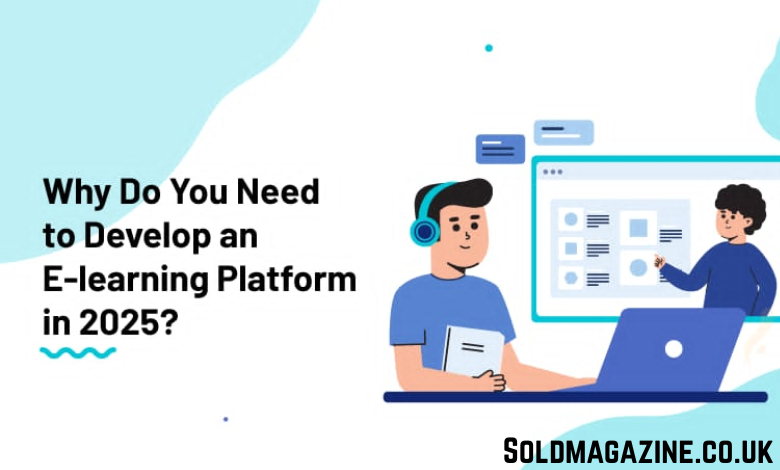The way people learn has changed forever. In 2025, learners expect education that’s flexible, accessible, and deeply personal. That’s why building your own e-learning platform isn’t just a smart business move, but a way to tap into one of the fastest-growing digital sectors.
An e-learning platform allows you to reach learners worldwide, create scalable revenue streams, and deliver measurable learning outcomes with the help of AI and data analytics. Whether your focus is skill development, corporate training, or niche education, an e-learning platform empowers you to deliver consistent and lasting value. By partnering with a company offering custom e-learning software development services, you can design a platform that addresses your audience’s unique needs.
This blog explores why 2025 is the ideal time for you to develop an e-learning platform, and what benefits it brings to your business.
Why 2025 Is a Turning Point for EdTech
Here’s why the timing has never been better for e-learning platform development:
AI is reshaping how people learn: Artificial Intelligence enables adaptive learning paths, smart assessments, and real-time feedback. In fact, AI-powered learning is the future of online education.
The workforce is reskilling at scale: Traditional degrees no longer guarantee relevance. Employees and freelancers are turning to digital learning for new skills. Companies are investing in online training to stay competitive, and they need robust platforms like yours to deliver it.
Digital access is finally universal: Affordable smartphones, 5G, and low-cost data have opened learning to millions across emerging markets. This global reach gives your platform the power to connect diverse learners, regardless of geography.
Learners expect personalized, bite-sized content: Today’s users prefer modular lessons, gamified experiences, and instant progress tracking. Building a platform around microlearning gives you an edge in engagement and retention.
Policy support is fueling EdTech adoption: Governments are prioritizing digital education through grants, accreditation frameworks, and public-private partnerships. Launching now positions your venture to leverage these incentives.
Top Reasons Entrepreneurs Should Invest in E-learning
The education landscape has shifted faster in the last 4-5 years than in the previous decade. What was once a backup plan during the pandemic has now become the primary mode of how people learn, teach, and grow. Here’s why you should be building or investing in an e-learning platform right now:
1. The Market Is Expanding, Fast – and Still Far from Saturated
The global e-learning market is projected to reach USD 842.64 billion by 2030, but it’s still fragmented. That means plenty of space for fresh players.
While large platforms focus on mass audiences, there’s a growing demand for niche, skill-specific platforms. These are the areas where smaller, agile startups can thrive.
Think about sectors like healthcare compliance, cybersecurity training, or STEM education for kids. Each of these is underserved, yet the demand curve is rising sharply.
By targeting a clear niche, you can establish authority faster and scale without competing head-on with giants. If you start building now, you’ll catch the wave before it matures – when the cost of entry is low and the rewards are high.
2. Scalability Without Heavy Infrastructure
Traditional education models require physical campuses, staff, and high overhead. E-learning doesn’t.
Once your platform is developed, scaling happens digitally. Whether you serve 100 or 10,000 users, the cost per learner barely moves.
Modern cloud infrastructure, low-code frameworks, and microservices architecture make this even easier. You can launch an MVP quickly and iterate as you grow.
Add AI features, expand into new geographies, or integrate with corporate systems, all without rebuilding your foundation.
3. Multiple Revenue Streams to Build Predictable Income
E-learning gives you more than one way to make money. You can start with a freemium model (free content + paid upgrades) or go fully subscription-based.
If your audience includes professionals or companies, you can charge for certifications, custom courses, or enterprise licensing.
Many successful founders also diversify through:
- Affiliate models: earning commission from partner content or tools.
- Marketplace models: letting trainers or experts sell through your platform.
- Corporate training packages: offering white-labeled learning solutions for HR departments.
4. Personalization and Data Are Your Competitive Edge
Static video lessons no longer interest learners. Nowadays, they look for courses that adapt to their pace, strengths, and interests.
With AI-driven analytics, you can track every learner’s interaction, quiz score, or time spent on topics. This data helps you improve the course design, recommend next steps, and even predict who might drop out.
The best part? This insight isn’t just good for education; it’s gold for business. Data helps you optimize marketing campaigns, reduce churn, and identify profitable segments faster.
5. Investor Confidence Is Stronger Than Ever
EdTech has become one of the most attractive sectors for venture capital. Even post-pandemic, when other sectors cooled, EdTech funding remained resilient because learning has shifted online.
If your platform uses AI, AR/VR, or data-driven engagement, you’re already in a high-interest zone. And even if you’re bootstrapping, the exit potential in this space is strong. Established players constantly acquire smaller, innovative platforms to expand their ecosystems.
6. Technology Makes Engagement Easier
One of the biggest challenges in e-learning has always been keeping learners motivated. But with 2025’s tech stack, you can overcome that.
Gamification tools let you integrate rewards, levels, and progress badges that trigger dopamine and keep users returning. Interactive formats – quizzes, AR-based simulations, or group projects – make learning immersive. Push notifications and reminders ensure learners stay on track.
By designing for engagement from day one, you build not just a product, but a habit-forming ecosystem.
7. Social Learning and Community Add Real Value
People learn better together. This is the reason why community-driven platforms are outperforming static ones. By adding peer discussions, live mentorships, or project collaboration, you can build emotional stickiness into your platform.
When learners connect, they return – not just for content, but for interaction. That’s a powerful differentiator, and it’s something that small, agile startups can build faster than large, bureaucratic players.
Emerging Technologies Shaping E-learning in 2025
Here are the key technologies driving the future of e-learning:
Generative AI Tutors: Personalized learning assistants that answer questions, explain concepts, and guide learners in real time.
Metaverse Classrooms: Virtual 3D environments where learners can collaborate, experiment, and practice hands-on skills safely and immersively.
Blockchain Credentials: Secure, verifiable digital certificates that make academic and professional achievements tamper-proof and globally recognized.
AR/VR Simulations: Immersive learning tools for practical training in medicine, manufacturing, aviation, or engineering. They bridge the gap between theory and practice.
Voice and Language AI: Real-time translation, voice recognition, and accent adaptation that make courses accessible to global audiences.
5G and Edge Computing: Faster connectivity and low latency that ensure seamless, high-quality video learning experiences, even in remote regions.
Conclusion
The world is ready for smarter, faster, and more inclusive education – and you have the tools to make it happen. With AI, cloud scalability, and personalized learning experiences, you can create an e-learning platform that shapes how people learn for years to come. If you’ve been waiting for the right time to build, scale, or pivot into EdTech, this is it.
FAQs
1. How do I decide what type of e-learning platform to build?
Start by identifying your audience and their pain points. Are you targeting professionals, schools, or corporations? Your choice should align with your target market’s learning habits, content format, and monetization goals.
2. What are the biggest challenges startups face in e-learning platform development?
Key challenges include creating engaging content, maintaining learner retention, ensuring platform scalability, and integrating secure payment systems. Choosing the right development partner and tech stack helps you overcome most of these early hurdles.
3. How can I ensure my e-learning platform stands out in a competitive market?
Differentiate through personalization, community features, and data-driven recommendations. Focus on user experience and meaningful engagement rather than generic course listings – this is where startups can outperform bigger players.
4. What are the must-have KPIs to track for an e-learning startup?
Track learner engagement rate, course completion rate, churn rate, active users, and customer acquisition cost (CAC). These metrics indicate whether your content, UX, and marketing strategies are working effectively.
5. Should I build a custom platform or use a white-label LMS?
If you want full control, scalability, and custom features, go for a custom-built platform. A white-label LMS works well for quick pilots or limited features but restricts flexibility in branding, integrations, and future upgrades.




